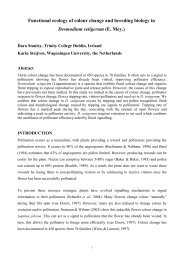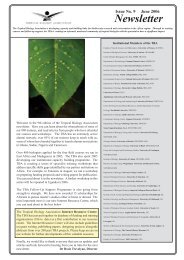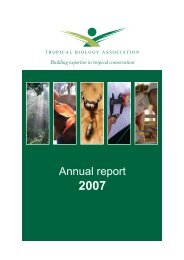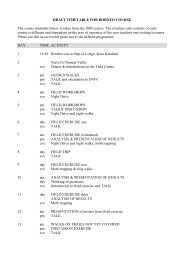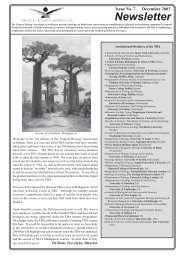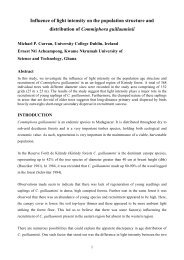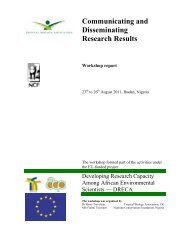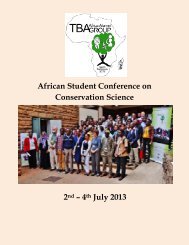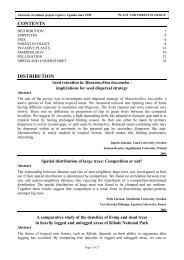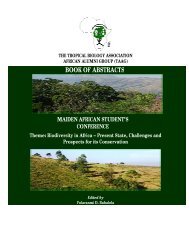Plant and forest ecology - Tropical Biology Association
Plant and forest ecology - Tropical Biology Association
Plant and forest ecology - Tropical Biology Association
You also want an ePaper? Increase the reach of your titles
YUMPU automatically turns print PDFs into web optimized ePapers that Google loves.
Abstracts of student project reports: Madagascar courses since 2002<br />
PLANT AND FOREST ECOLOGY<br />
Abstract<br />
Forest structure on a soil gradient in Kirindy Forest<br />
(Menabe region, Madagascar)<br />
Though the dry deciduous <strong>forest</strong> of Kirindy has been studied, little of this research has drawn<br />
attention to how significant the role of evergreens is within the <strong>forest</strong> structure. Field observation<br />
suggested not only that evergreen plants are an important component of the vegetation but also that<br />
the <strong>forest</strong> structure changed across different soil types. With this project, we found a significant<br />
relationship between the soil type <strong>and</strong> the frequency of deciduous <strong>and</strong> evergreen plants <strong>and</strong> average<br />
height of canopy. We are however unable to identify this relationship as dependency or correlation<br />
with unstudied factors.<br />
Abstract<br />
George Percival, National University of Irel<strong>and</strong> Galway, Irel<strong>and</strong><br />
Nuno Veríssimo Pereira, Georg-August-Universität Göttingen (Germany), Portugal<br />
Tendai Musvuugwa, University of Cape Town (South Africa), Zimbabwe<br />
Forest structural variables <strong>and</strong> evergreen tree composition<br />
along the Kirindy river<br />
The structural variables (height, dbh ≥10 cm, density) <strong>and</strong> evergreen species composition of trees of<br />
the riparian <strong>forest</strong> were investigated across the Kirindy river. 20 transects were set up<br />
perpendicularly to the river to sample the vegetation.There was variation in the dbh, tree density<br />
<strong>and</strong> species composition only within twenty metres. This is probably because the river has an<br />
influence only within twenty metres over the vegetation of the riparian <strong>forest</strong>. Probably more<br />
transects <strong>and</strong> other components such as soil types <strong>and</strong> degree of humidity have to be studied during<br />
the rainy season to clearly establish the influence of the river on the vegetation.<br />
2009<br />
Djomo Nana Eric, University of Yaounde, Cameroon<br />
Chabi A.M.S. Djagoun, University of Abomey-Calavi, Benin<br />
Noelikanto Ramamonjisoa, University of Antananarivo, Madagascar<br />
Regeneration in logging trails in comparison to the adjacent lightly logged <strong>forest</strong><br />
in Kirindy: the case of Strychnos decussata as a focus species<br />
Abstract<br />
The operation of silviculture, despite selective timber felling, has impacts on a <strong>forest</strong> <strong>and</strong> its ability<br />
to recover. The ability to recover can be assessed for example by the faculty of the regeneration of<br />
the <strong>forest</strong>. Using a paired transect sampling methodology we investigated the differences of tree<br />
regeneration between logging trails <strong>and</strong> adjacent lightly logged <strong>forest</strong>. Our focus on Strychnos<br />
decussata enabled us to further analyse a specific tree species to assess the regeneration <strong>and</strong> its<br />
ability to colonise the gaps created by logging trails. Results indicated there was a statistically<br />
significant difference between the logging trails <strong>and</strong> lightly logged <strong>forest</strong> in terms of environment,<br />
excluding stem count. There was no significant difference between the stem counts of the logging<br />
trails <strong>and</strong> lightly logged <strong>forest</strong>. Ring count analyses of harvested Strychnos decussata found that<br />
saplings under the height of 0.5 m were aged less than 10 years old indicating new regeneration.<br />
This age analysis equation was applied to the Strychnos decussata found within the paired transects.<br />
Regeneration is more favourable in lightly logged <strong>forest</strong> than logging trails indicating the impact of<br />
past <strong>forest</strong>ry operations on regeneration rates.<br />
2009<br />
Page 3 of 11




